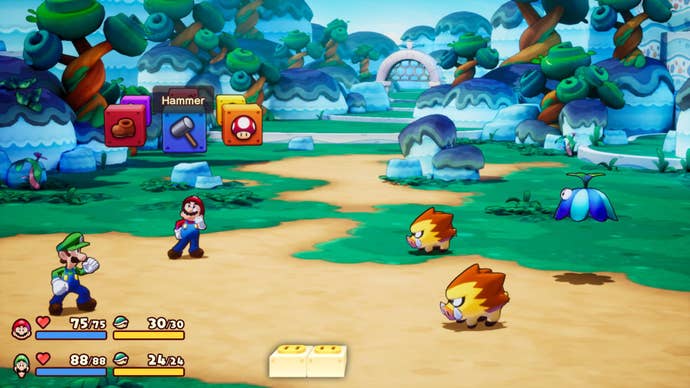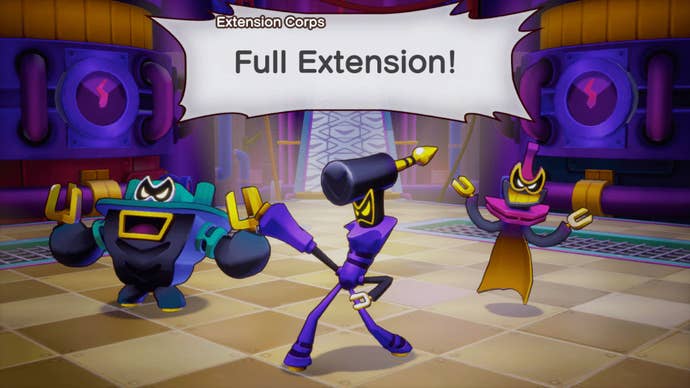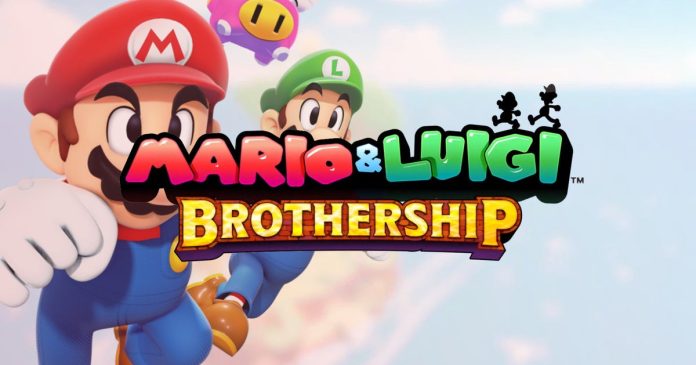If I had to choose a single word to describe Mario & Luigi: Brothership after an hour or so seeing a few different areas of the near-final game, that word is up there in the headline: it’s delightful. If I had to choose a second, well… let’s go for refreshing.
It feels a bit like the Mario & Luigi series never really left. When you think about it, though, it’s been the better part of a decade since we actually had a new one of these games. 2015’s Paper Jam was an all-new game, but the subsequent titles between then and now have been remakes of older games. In 2019, it looked like the series might be over, as Mario & Luigi developer AlphaDream hit the rocks and filed for bankruptcy. But here we are, nine years since the last original game, and we have an all-new one.
When quizzed about who exactly is making this one, Nintendo reps do the usual ‘look at the credits once it’s out’ song and dance, but do reassure that “some of the original developers” behind the franchise have worked on this entry, likely through a mix of Nintendo-side producers and employees scooped up after AlphaDream’s collapse.
Anyway, the headline is this: after relatively uninspired remakes that I always felt were just slightly worse versions of the DS and GBA games they were remaking, this is the franchise back on form. This is the first Mario & Luigi I’m truly excited to play since, well, Paper Jam. Actually, I find it more immediately exciting than either of the 3DS games – putting this on a level pegging with some of the franchise’s best.
All of these games require a gimmick, obviously – some central conceit that powers everything from the gameplay systems to the plot. The clue is as always in the title – this time around, everything is driven by Mario & Luigi’s bond as brothers, with the duo able to team up in a variety of ways – some familiar, some new – in order to tackle challenges.
The majority is, I admit, pretty familiar. The turn-based RPG battles set the game up as a great kids’ first RPG, with simple combat options that nevertheless provide decent depth. Timing is crucial – attack with Mario’s Hammer and there’ll be a little button press alongside the animation to make the attack maximally effective. The brotherly bond is driven home by the brothers each having a button in these interactions – so in Luigi’s jump attack, you’ll press B timed with Luigi’s jump, then A – the Mario button – to have Mario volley Luigi back towards the enemy for a second jump, which requires you press B again as Luigi slams onto the enemy’s head.
Some of the RPG world’s more traditional complications are stripped out, or augmented for simplicity – so there’s not elemental affinity stuff as such, but you have to consider stuff like how a Hammer attack will whiff on a flying enemy, but a jump attack is perfect -while jumping straight onto an enemy with a spikey crown is obviously not a very smart idea.
It’s soft, fluffy, light RPG action – but I think it looks like it’s going to thread the needle well as something an adult can play relatively stress-free; a panacea for a tough day or a nasty hangover – while simultaneously being engaging as an early gateway to these sorts of mechanics for younger players. It’s when this balance is found that the Mario RPG games are at their best.

There’s much new, of course. There’s a new setting, where Mario & Luigi are catapulted to a mysterious new land with an electrical theme – even its inhabitants are plug-like people. The land has been shattered from one united mass into a smattering of islands – though through the work of Mario & Luigi, the disparate islands will slowly be drawn back together into one united land again.
The titular Brothership isn’t quite a literal ship – it’s one of those islands, though one that can be piloted around like a ship. You reach islands by sailing close to them and then blasting over in a cannon; each island then contains its own little narrative, series of puzzles, and so on.
Much of the joy comes in travelling these islands. In the hands-on, I take on a little maze puzzle. The solution is a clever use of the Brotherhood: you split Mario & Luigi up. Mario clambers a tall tower, which in turn raises the camera perspective so you can see the whole maze. Luigi stays behind, next to a switch that rotates part of the circular maze, moving the various entrances and exits. With the two split up, you press Luigi’s action button to hammer the switch and rotate the maze until you’ve got a viable route through.

In another instance, the brothers have to escort a terrified NPC through a forest of bugs, which she hates. Because each can’t jump while carrying their charge, you have to pass her back and forth – tossing her from Mario to Luigi, allowing Mario to jump ahead across some light platforming challenges – then toss her back, allowing Luigi to follow. Environmental puzzles like this are all over each area.
There’s a lot of this: the power of the brothers together, but also the power of them splitting up, working together but from more of a distance. It’s a lovely idea, and is then also utterly sold by gorgeous animations. I recommend letting one of the brothers get downed in combat just to see the very sweet animation of the other. Likewise for letting one of the in-combat QTEs fail – it all oozes style and love. Even the narrative is as such; full of little references, sweet dialogue, and quiet revelations – did you know Mario uses wax in his impeccable moustache?
If you want a little more depth in combat, it is there – primarily led by a new combat mechanic, ‘plugs’. These plugs (which are like electrical plugs, by the way – don’t go there) can be equipped by Mario & Luigi, unlocking clever bonuses. Plugs allow things like adding area-of-effect bonuses to well-timed attacks or applying status effects during certain conditions and so on. Plugs can also be used to augment combat in general – so if you’re struggling with the timing of counters, a plug can make it easier. If you’re forgetful, there’s an ‘auto mushroom’ plug, which functions just as an auto potion healing skill does in other RPGs.

Plugs are crafted by the player one-by-one, with a crafting recipe book unlocking more options the more plugs you’ve crafted. Once one has been crafted, it’s permanent – but each plug has a limited number of charges. After, say, 20 uses, a plug becomes non-functional until it has lay dormant, given time to recharge. You can swap out plugs in the menu, or even mid-combat – so the idea is clearly that you’ll have Mario & Luigi slamming in a new plug as soon as their existing one runs out of charge, or even just because a different plug might be more suitable for the situation.
Like I say – these games are, at their heart, ‘baby’s first RPG’ stuff. But to see the depth the plugs bring is interesting – and I’m most intrigued to see what the late-game plugs will look like. I anticipate decent depth. These games trade largely on vibes and feelings – on having a feel-good factor, a warm fuzzy hug of a game. But the depth is welcome, too. At first blush, this does appear to be the most interesting Mario RPG in many years on just about every level – and I can’t wait to play the final thing.
Mario & Luigi: Brothership hits Nintendo Switch on November 7th.

